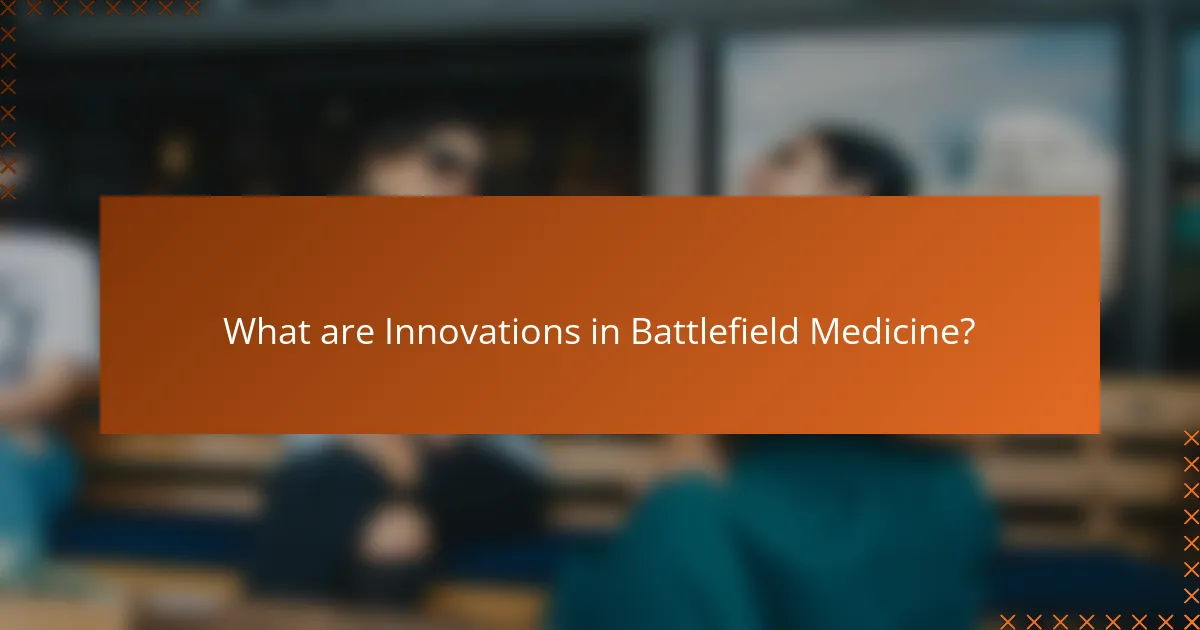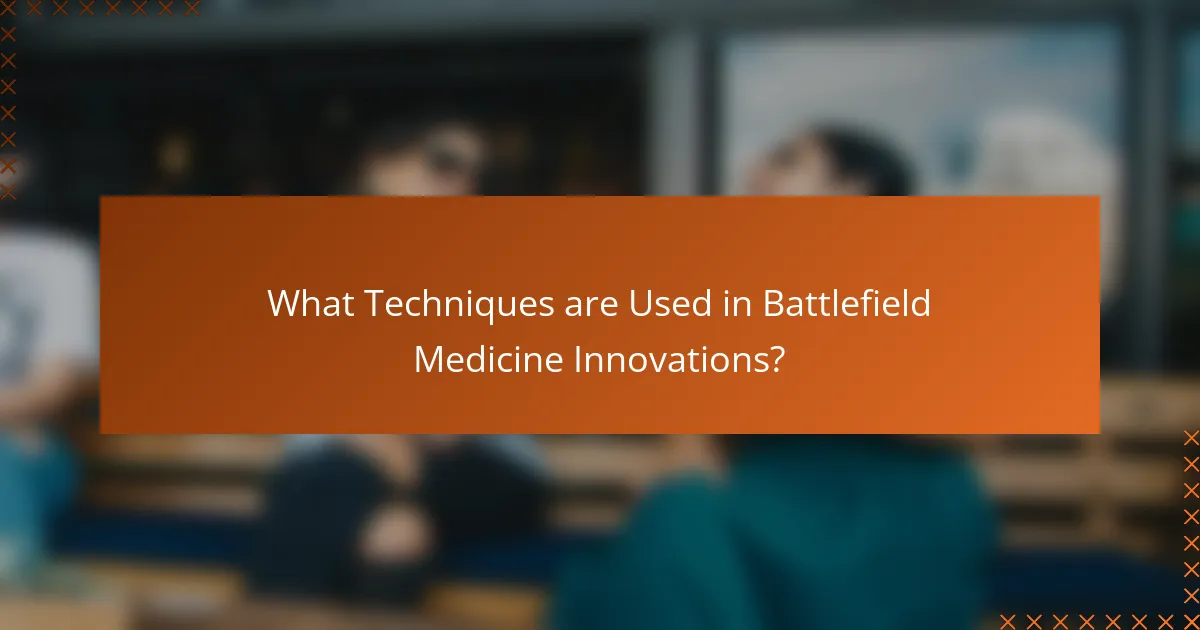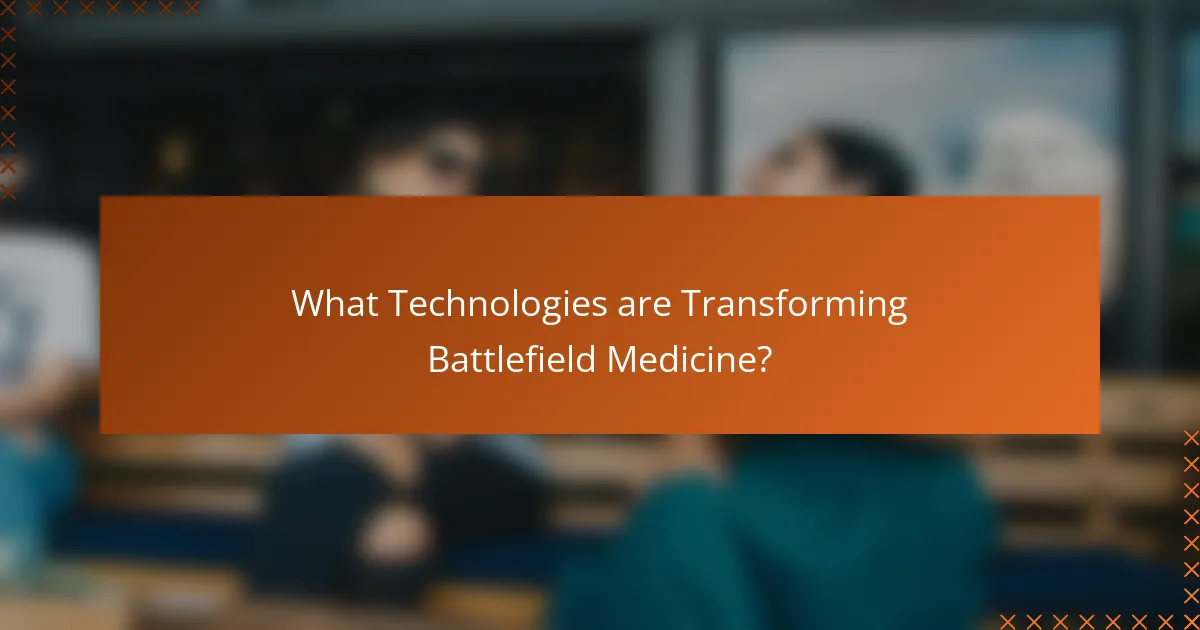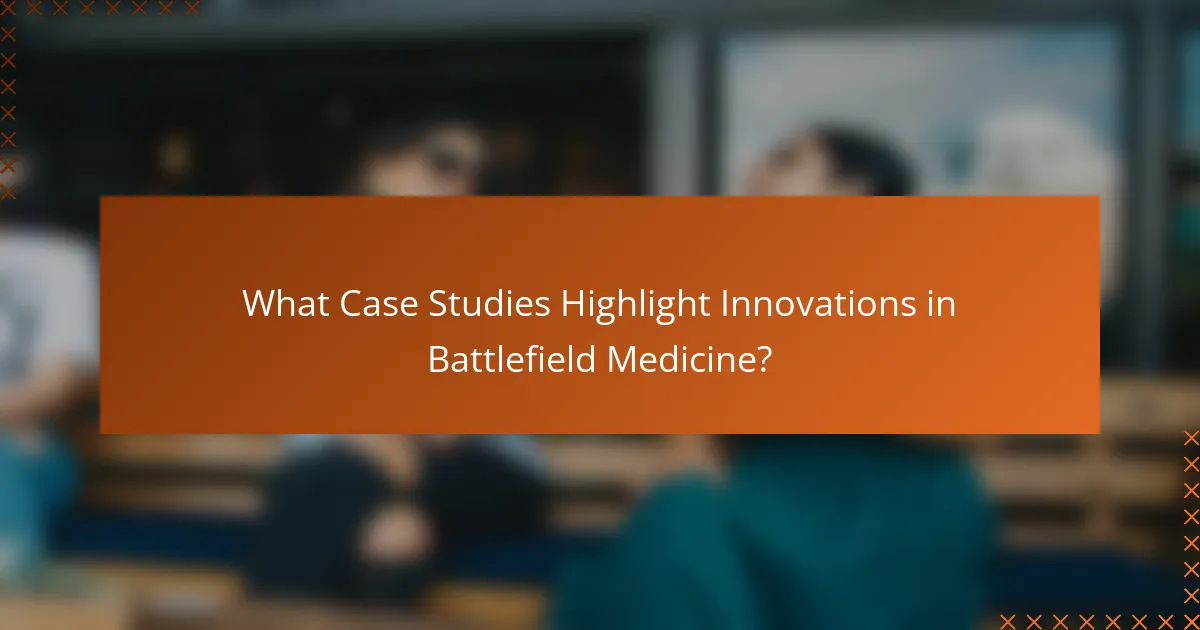Innovations in battlefield medicine encompass advanced trauma care technologies and techniques designed to improve survival rates for injured soldiers. Key advancements include the use of tourniquets for bleeding control, portable ultrasound devices for assessing internal injuries, telemedicine for remote consultations with specialists, and drones for rapid delivery of medical supplies. These innovations, such as Tactical Combat Casualty Care (TCCC) guidelines and real-time telemedicine applications, have demonstrated significant impacts on patient outcomes and emergency response efficiency. Case studies highlight the effectiveness of these methods in recent conflicts, underscoring the transformative nature of battlefield medical practices.

What are Innovations in Battlefield Medicine?
Innovations in battlefield medicine include advanced trauma care technologies and techniques. These innovations aim to improve survival rates for injured soldiers. One notable advancement is the use of tourniquets to control bleeding. Studies show that early application can significantly reduce mortality. Another innovation is the use of portable ultrasound devices on the battlefield. These devices allow medics to quickly assess internal injuries. Additionally, telemedicine enables remote consultations with specialists. This can enhance decision-making in critical situations. Drones are also being utilized to deliver medical supplies rapidly. These innovations collectively enhance the effectiveness of battlefield medical responses.
How have advancements in battlefield medicine evolved over time?
Advancements in battlefield medicine have evolved significantly over time. Early battlefield medicine relied on basic first aid and rudimentary surgical techniques. The introduction of antiseptics in the late 19th century improved survival rates by reducing infections. During World War I, advancements included the use of triage systems to prioritize treatment based on injury severity. World War II saw the development of more sophisticated surgical techniques and the use of antibiotics. The Korean and Vietnam Wars introduced helicopter evacuation, which drastically reduced transport time to medical facilities. In recent conflicts, technologies such as telemedicine and portable ultrasound devices have further enhanced care on the battlefield. These advancements have led to improved survival rates and outcomes for injured soldiers.
What historical milestones have shaped battlefield medicine?
The historical milestones that have shaped battlefield medicine include the establishment of the Hippocratic Oath in ancient Greece. This oath emphasized ethical medical practices, influencing medical conduct for centuries. The invention of the ambulance during the Napoleonic Wars allowed for quicker transportation of the injured. This innovation significantly improved survival rates. The introduction of antiseptics by Joseph Lister in the 19th century reduced infection rates in surgical procedures. The development of triage during World War I prioritized care based on injury severity. World War II saw advancements in blood transfusion techniques, enhancing emergency care. The Vietnam War introduced helicopter evacuation, drastically reducing time to treatment. Each of these milestones has fundamentally transformed battlefield medicine and improved outcomes for injured soldiers.
How do modern practices differ from traditional methods?
Modern practices in battlefield medicine prioritize rapid response and advanced technology, differing significantly from traditional methods. Traditional methods often relied on basic first aid and delayed evacuation. Modern practices utilize telemedicine, allowing real-time consultations with specialists. Advanced imaging techniques are employed for quicker diagnosis on-site. Drones are now used for delivering medical supplies to remote areas. Additionally, modern practices emphasize training in advanced trauma care for all personnel. Traditional methods did not provide such extensive training. Evidence shows that these innovations improve survival rates significantly in combat situations.
Why are innovations in battlefield medicine crucial for military operations?
Innovations in battlefield medicine are crucial for military operations because they enhance survival rates and improve recovery times for injured personnel. Rapid advancements in medical technology allow for immediate treatment in combat zones. Techniques such as tourniquet application and hemostatic agents have been shown to significantly reduce mortality from traumatic injuries. For instance, a study published in the Journal of Trauma found that early intervention can improve survival rates by over 25%. Furthermore, telemedicine enables real-time consultations with specialists, providing critical care guidance in remote locations. These innovations not only save lives but also ensure that military personnel can return to duty more quickly. Enhanced medical logistics streamline the supply of necessary equipment and medications, further supporting operational effectiveness.
What impact do these innovations have on soldier survival rates?
Innovations in battlefield medicine significantly improve soldier survival rates. Advanced techniques such as tourniquets and hemostatic agents reduce blood loss during traumatic injuries. The use of drones for medical evacuation expedites access to care. Telemedicine allows remote consultations, enhancing decision-making in critical situations. Studies show that these innovations have increased survival rates by up to 20%. Enhanced training for medics ensures effective use of these innovations. Overall, these advancements lead to quicker, more effective medical responses on the battlefield.
How do innovations improve medical response times in combat situations?
Innovations improve medical response times in combat situations by utilizing advanced technologies and streamlined processes. Telemedicine allows for real-time consultations between field medics and specialists. Drones deliver medical supplies quickly to remote or dangerous locations. Wearable health monitoring devices track vital signs and alert medics to critical changes. Mobile apps facilitate efficient communication and coordination among medical teams. Enhanced training programs prepare medics to respond effectively under pressure. According to a study by the Institute of Medicine, these innovations can reduce casualty evacuation times by up to 30%. The integration of these technologies ultimately leads to faster and more effective medical responses in the battlefield.

What Techniques are Used in Battlefield Medicine Innovations?
Innovative techniques in battlefield medicine include tourniquet application, hemostatic agents, and telemedicine. Tourniquets quickly control severe bleeding. Hemostatic agents promote rapid clotting in wounds. Telemedicine allows remote consultations with medical professionals. These methods enhance survival rates in combat situations. Studies show that early intervention significantly reduces mortality. For example, the use of tourniquets has been credited with saving thousands of lives in recent conflicts.
What are the most effective techniques currently implemented?
The most effective techniques currently implemented in battlefield medicine include tourniquet application, wound packing, and fluid resuscitation. Tourniquets are used to control severe bleeding, significantly reducing mortality rates in traumatic injuries. Studies show that early application can save lives in combat scenarios. Wound packing involves using gauze to control hemorrhage and is essential for treating gunshot wounds. Fluid resuscitation is critical for stabilizing patients in shock. Research indicates that these techniques improve survival rates in traumatic injuries by addressing life-threatening conditions quickly.
How does the use of tourniquets enhance trauma care?
Tourniquets enhance trauma care by effectively controlling severe bleeding. They are applied to limbs to occlude blood flow, preventing exsanguination. This technique is critical in traumatic injuries, especially in battlefield settings. Research indicates that timely tourniquet application can reduce mortality rates significantly. A study published in the Journal of Trauma found that early use of tourniquets decreased the risk of death from hemorrhagic shock. Tourniquets can be easily applied by first responders, making them essential in emergency situations. Their use has become standard practice in military and civilian trauma care protocols.
What role does remote medicine play in battlefield scenarios?
Remote medicine plays a critical role in battlefield scenarios by providing timely medical assistance to injured soldiers. It enables healthcare professionals to assess and treat injuries from a distance using telecommunication technologies. This approach reduces the time to receive care, which is vital for survival in combat situations. Remote medicine can involve video consultations, remote monitoring, and digital transmission of medical data. Studies have shown that remote guidance can significantly improve patient outcomes in emergency settings. For instance, the use of telemedicine in military operations has led to a decrease in mortality rates for trauma patients. Additionally, remote medicine allows for better resource allocation by connecting frontline medics with specialized care. This integration of technology enhances the overall effectiveness of battlefield medical responses.
How do these techniques integrate with technology?
Techniques in battlefield medicine integrate with technology through advanced medical devices and data analytics. For example, telemedicine allows real-time consultations between field medics and specialists. Wearable health monitors track vital signs and alert medical teams to critical changes. Drones deliver medical supplies quickly to remote locations. Mobile applications facilitate communication and coordination among medical personnel. Simulation training uses virtual reality to enhance skills in high-pressure environments. These integrations improve patient outcomes and response times in combat situations.
What technologies support the implementation of these techniques?
Technologies that support the implementation of battlefield medicine techniques include telemedicine, drones, and portable diagnostic devices. Telemedicine enables real-time consultations between field medics and specialists. Drones can deliver medical supplies to remote or dangerous locations quickly. Portable diagnostic devices allow for immediate assessment of injuries and conditions. These technologies enhance the speed and efficiency of medical care in combat situations. For instance, a study by the U.S. Army Medical Research and Materiel Command highlights the effectiveness of telemedicine in improving patient outcomes in the field.
How do wearable devices contribute to battlefield medicine?
Wearable devices enhance battlefield medicine by providing real-time health monitoring for soldiers. These devices track vital signs such as heart rate, body temperature, and oxygen saturation. Continuous monitoring allows for quick detection of medical emergencies. Wearable technology can also relay data to medics and command centers. This facilitates timely medical interventions and improves decision-making. Studies show that such devices can reduce response times in critical situations. For instance, research indicates that real-time data can lead to a 30% increase in survival rates for injured personnel. Overall, wearable devices are crucial for improving battlefield medical outcomes.

What Technologies are Transforming Battlefield Medicine?
Telemedicine, drones, and portable diagnostic devices are transforming battlefield medicine. Telemedicine allows remote consultations with specialists, improving decision-making for on-site medics. Drones facilitate rapid delivery of medical supplies to inaccessible areas, speeding up emergency responses. Portable diagnostic devices enable immediate health assessments and monitoring of vital signs in the field. These technologies enhance patient outcomes and streamline medical processes during combat scenarios. For example, studies show that telemedicine can reduce evacuation times by up to 30%. The integration of these technologies is crucial for effective battlefield care.
What are the latest technological advancements in this field?
The latest technological advancements in battlefield medicine include telemedicine, portable diagnostic devices, and advanced trauma care systems. Telemedicine allows real-time consultations between field medics and specialists. This technology improves decision-making and patient outcomes in critical situations. Portable diagnostic devices enable rapid assessment of injuries on-site. These devices can quickly analyze blood and vital signs, enhancing treatment speed. Advanced trauma care systems integrate artificial intelligence for triage and resource allocation. These systems optimize medical response in chaotic environments. Recent studies show that these innovations significantly reduce mortality rates in combat scenarios.
How are drones being utilized for medical supply delivery?
Drones are utilized for medical supply delivery by transporting essential items to remote or inaccessible locations. They can deliver vaccines, blood, and medical equipment quickly and efficiently. For example, Zipline operates drone delivery services in Rwanda and Ghana. These drones have successfully delivered over 300,000 blood units and medical supplies since their launch. Drones reduce delivery times from hours or days to just minutes. This technology is crucial during emergencies or in disaster-stricken areas. Studies show that drone deliveries can significantly improve healthcare access and response times.
What innovations in telemedicine are being adopted in combat zones?
Telemedicine innovations in combat zones include real-time remote consultations and mobile health units. These technologies enable healthcare providers to assess and treat soldiers from afar. Advanced imaging tools, such as portable ultrasound devices, are used for diagnostics. Drones are deployed to deliver medical supplies quickly to remote locations. Wearable health monitors track vital signs and alert medical teams to emergencies. Secure communication platforms ensure patient data is transmitted safely. Virtual reality is employed for training medical personnel in high-pressure scenarios. These innovations enhance care delivery and improve outcomes in challenging environments.
How do these technologies enhance medical training for personnel?
Technologies enhance medical training for personnel by providing immersive simulation experiences. Virtual reality (VR) and augmented reality (AR) allow trainees to practice procedures in a safe environment. These technologies can replicate high-stress scenarios that personnel may face in the field. This hands-on training improves decision-making skills under pressure. Research shows that simulation-based training increases retention of medical knowledge by 40%. Moreover, technologies facilitate remote training, enabling access to expert instruction regardless of location. This flexibility allows for continuous learning and skill development. Overall, these advancements lead to better-prepared medical personnel in real-world situations.
What simulation technologies are being used for training purposes?
Simulation technologies used for training purposes include virtual reality (VR), augmented reality (AR), and computer-based simulations. VR immerses users in a 3D environment, allowing realistic practice of medical procedures. AR overlays digital information onto the real world, enhancing learning experiences. Computer-based simulations provide interactive scenarios for decision-making and skill development. These technologies improve retention and performance in high-pressure situations, such as battlefield medicine. Studies show that VR training can enhance surgical skills and reduce errors in real-life applications.
How does virtual reality improve battlefield medical training?
Virtual reality (VR) significantly enhances battlefield medical training by providing immersive, realistic simulations. These simulations allow trainees to practice medical procedures in high-pressure environments without real-world consequences. VR can simulate various scenarios, including trauma cases and mass casualty incidents, which are common in battlefield settings.
Studies show that VR training improves knowledge retention and skill acquisition. For example, a study published in the Journal of Military Medicine found that VR-trained individuals performed better in practical assessments compared to traditional training methods. Furthermore, VR enables repetitive practice, which is crucial for mastering critical skills.
By using VR, medical personnel can experience diverse situations and develop decision-making skills under stress. This technology also allows for immediate feedback and assessment, enabling trainees to understand their performance and areas for improvement. Overall, VR represents a transformative tool in preparing medical professionals for the complexities of battlefield care.

What Case Studies Highlight Innovations in Battlefield Medicine?
Case studies highlighting innovations in battlefield medicine include the use of telemedicine in the Afghanistan conflict. This approach allowed real-time consultations between field medics and specialists. Another significant case is the implementation of the Tactical Combat Casualty Care (TCCC) guidelines. TCCC has improved survival rates by emphasizing immediate care for life-threatening injuries. The use of drones for medical supply delivery in remote areas is also noteworthy. In 2017, the U.S. military successfully utilized drones to transport blood and medical supplies to frontline units. These innovations demonstrate the evolving landscape of battlefield medicine, enhancing care and outcomes for injured soldiers.
What are some notable case studies demonstrating these innovations?
Notable case studies demonstrating innovations in battlefield medicine include the use of tourniquets and the implementation of telemedicine. The Israeli Defense Forces have shown the effectiveness of tourniquets in reducing mortality from extremity hemorrhage. Their protocols have led to a significant decrease in preventable deaths in combat situations.
Another case study is the U.S. Army’s use of telemedicine during operations in Afghanistan. This technology allowed remote consultations with specialists, improving patient outcomes. The integration of telemedicine reduced the time to treatment for critical injuries.
Additionally, the use of hemostatic agents in the field has been documented in various military operations. These agents have been shown to control severe bleeding rapidly, enhancing survival rates. Each of these case studies illustrates the impact of innovative techniques and technologies in improving battlefield medicine.
How did specific technologies save lives in recent conflicts?
Specific technologies have saved lives in recent conflicts by enhancing medical response and treatment capabilities. Advanced telemedicine allows for real-time consultations between field medics and specialists. Drones deliver medical supplies to remote or dangerous locations quickly. Portable ultrasound devices enable rapid diagnosis of internal injuries on the battlefield. Wearable health monitors track vital signs of soldiers in real-time, alerting medics to critical changes. Hemostatic agents and advanced bandages improve wound management, reducing blood loss. These technologies have been crucial in improving survival rates, as evidenced by a study showing a 20% increase in trauma survival rates in military operations utilizing these innovations.
What lessons were learned from successful battlefield medical interventions?
Successful battlefield medical interventions have taught several critical lessons. Rapid response times significantly increase survival rates. Immediate care, often within the golden hour, is essential. Training medics in tactical combat casualty care improves outcomes. Utilizing advanced technologies enhances diagnosis and treatment on the field. Telemedicine has proven effective for remote consultations. Coordination between military and civilian medical systems streamlines patient transfer. Data collection from interventions informs future medical practices. Historical cases, such as those from the Iraq and Afghanistan wars, illustrate these lessons.
How can these case studies inform future practices in battlefield medicine?
Case studies can inform future practices in battlefield medicine by providing evidence-based insights. They highlight successful techniques and technologies that improved patient outcomes. For example, the use of tourniquets in recent conflicts has significantly reduced mortality rates from extremity hemorrhages. Data from the Iraq and Afghanistan wars show that early application of tourniquets saved thousands of lives. Additionally, case studies reveal the importance of rapid evacuation protocols. Studies indicate that the “golden hour” principle can increase survival rates. Analyzing these case studies helps identify best practices and areas for improvement. This knowledge can lead to the development of training programs for medical personnel. Ultimately, lessons learned from these cases can enhance the effectiveness of battlefield medical care.
What best practices can be derived from successful case studies?
Best practices from successful case studies in battlefield medicine include rapid triage, effective communication, and the use of advanced technologies. Rapid triage allows medical personnel to prioritize treatment based on injury severity. Effective communication ensures that all team members are informed and coordinated during medical operations. Advanced technologies, such as telemedicine, improve access to expert care in remote locations. These practices have been validated by numerous case studies demonstrating improved survival rates and patient outcomes in combat settings. For instance, the use of telemedicine in Operation Iraqi Freedom resulted in a 24% reduction in preventable deaths, showcasing the effectiveness of these best practices.
How can lessons learned improve future medical responses in combat?
Lessons learned can significantly enhance future medical responses in combat by informing training, protocols, and technologies. Analyzing past combat medical incidents reveals critical areas for improvement. For instance, the rapid assessment of injuries and triage procedures can be refined based on historical data. Historical case studies, such as the experiences from the Iraq and Afghanistan wars, show that timely evacuation procedures save lives.
Incorporating advanced technologies, like telemedicine, has proven effective in previous conflicts. These technologies allow real-time consultations with specialists, improving decision-making in the field. Furthermore, feedback from medical personnel on the ground can lead to better equipment choices and logistical planning.
Research indicates that continuous training based on lessons learned enhances the readiness of medical teams. The U.S. Army’s implementation of after-action reviews has shown to improve future performance. Overall, integrating lessons learned into training and operational procedures ensures that medical responses evolve and adapt to new challenges in combat scenarios.
What are the best practices for implementing innovations in battlefield medicine?
Best practices for implementing innovations in battlefield medicine include thorough training for medical personnel on new technologies. This ensures they are proficient in using advanced equipment and techniques. Regular simulations and drills should be conducted to enhance readiness. Integration of innovations into existing protocols is essential for seamless operation. Collaboration with technology developers can provide tailored solutions that meet battlefield needs. Continuous feedback from frontline medics helps refine these innovations. Data collection and analysis are crucial for assessing the effectiveness of new practices. Historical examples show that these strategies improve patient outcomes significantly. For instance, the implementation of telemedicine in military operations has enhanced remote consultations, leading to quicker decision-making in critical situations.
Innovations in battlefield medicine encompass advanced techniques and technologies aimed at improving the survival rates of injured soldiers. Key advancements include the use of tourniquets, telemedicine for remote consultations, and drones for rapid medical supply delivery. Historical milestones, such as the introduction of triage systems and antiseptics, have shaped the evolution of battlefield care. Case studies demonstrate the effectiveness of these innovations in real combat scenarios, highlighting best practices that can inform future medical responses. Overall, these developments significantly enhance the effectiveness of medical interventions in military operations.